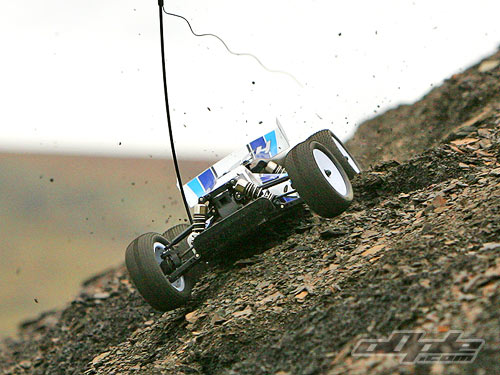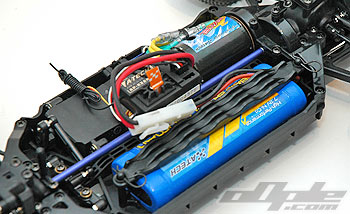 |
The layout should be familiar to most people reading this, using a plastic tub chassis and centre shaft drive, this car has the same general lay out to the Kyosho ZX-5 and other four-wheel shaft driven buggies and touring cars, like the TC3- with the battery pack on the left hand side, and all other electrics on the right.
The Electronic Speed Controller, or ESC, is on the large side and takes up the rest of the room on the chassis right hand side.
The unit is black with a little identifying sticker hidden away on the side proclaiming the name A-Tech Excel – Fet Speed Controller. |
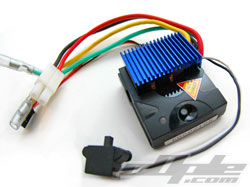 |
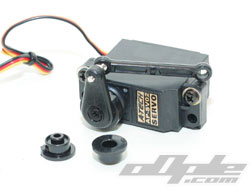 |
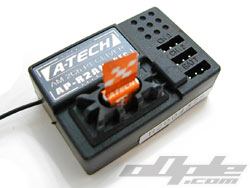 |
A large blue heat sink takes care of cooling from the four large FETs inside. If you take off the heat sink, you can see inside and its easy to notice the vast amount of unclaimed real estate in that large plastic box. If you want to bring a packed-lunch, just stick it in here.
As a consequence of the large ESC, the standard sized receiver is placed on a plastic bracket in the centre of the car ‘floating’ above the centre drive shaft. Placing it in the area of the drivers cockpit.
The receiver is again A-Tech branded and is a 27mhz AM 2-channel type.
The motor is a black can, sealed end-bell type. There is no indication of ‘wind, just the words “High Performance”.
This is located on the right of the chassis at the rear. The motor is geared on a 20 tooth pinion and drives a 60 tooth spur gear. These gears are hidden from small stones and dirt via a cover which also acts to secure the motor and centre shaft in place.
Steering comes from a standard sized A-Tech branded servo, the AP-SV02. The servo moves a rack from a centre pickup, with links to the steering knuckles at either end. This rack moves on twin bell cranks located as part of the pivot block behind the front gearbox.
The thing that really jumps out about the steering on the BX-1 is the swept-forward steering links. These just don’t look quite right but steering seems good, though steering-lock could be a little better. |
|
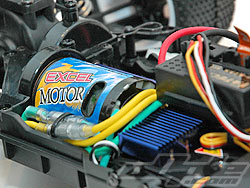 |
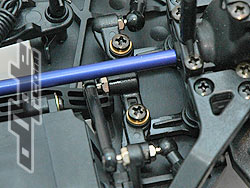 |
The receiver wire is bound up inside the car for packaging reasons and needs to be unravelled and the included aerial tube installing in the chassis.
You’ll also have to make a hole in the body shell for the aerial to exit. There is a small ‘bump’ under a sticker on the right front wing of the shell, I used a body shell reamer to make a hole but a drill or carefully handled craft knife would do the job.
My kit came with battery and charger – depending on importer this might change of course.. The car I have here being an early example straight from the factory, the plug on the included battery charger was wrong (for the UK) so I used my own. The included 7.2v ‘Tamiya-style stick battery’ is a NiCd pack and is rated at 2000mah, which should provide decent running time with the included motor.
With the cells on charge, I turned my attention to the transmitter.
This is a “steer wheel” style unit in black plastic with yellow trim. Initial impression is not great until you realise this is a Incredible value RTR kit – at which point the unit feels good for its price level. Looks and price aside, the transmitter actually feels quite good in the hands. Closer inspection reveals some functions which raise the spec above basic level. Dual Rates (adjustable steering throw - or the amount of total steering the car has) and end point adjustments are included along side the usual trims and reversing functions.
The transmitter requires 8 ‘AA’ batteries, not included. These fit into the base of the transmitter. This initially confused me since there is no indication of cell arrangement in the compartment, I tried them alternate positive / negative at first, then all the same way and finally randomly arranged! The conclusion is that any cell arrangement will do! Great for dummys but also confusing since you don’t want to get it wrong – perhaps some indication of this feature should be in the manual. |
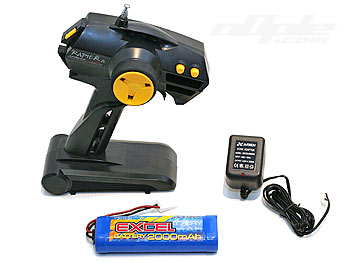 |
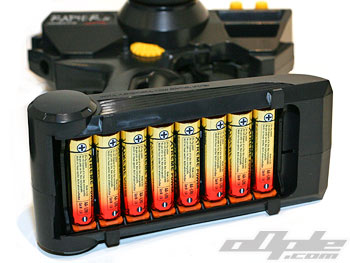 |
Cells can be arranged in any formation |
|
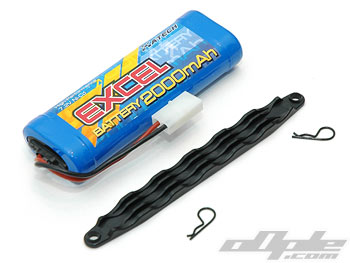 |
Preparing the car for action
With the battery charged I installed it in the left hand side of the chassis. This is then held in place with a long plastic brace by two pins. The brace, just like the chassis is capable of handling stick packs of the type included, along with side-by-side cell configurations - which sit slightly lower in the provided chassis cutouts.
With the transmitter on and battery hooked up, I turned the car on via the switch on the right of the chassis. That was mistake number one, since the car immediately created havoc on my messy desk by moving off over my carefully arranged junk pile.
Obviously the throttle trim was not quite right. I have little doubt this was not correct from the factory, I had most likely knocked it out of position slightly when examining the transmitter - oops. |
No matter, with the car switched off and now sat raised-up on something, so all four wheels were lifted in the air - I tried again. This time instead of shooting off across my table, the wheels just span forwards at moderate speed. Using the throttle position trim on the transmitter I adjusted the throttle until the wheels were stationary.
Everything else seemed fine, the steering was centred perfectly and throttle high and low points (full forward, and full reverse) were set perfectly.
I put the car down for the customary “kitchen floor rally”, shh, don’t tell my wife. The thing I noticed straight away was the cars lack of brakes, instead, pushing back on the trigger engages reverse – even when going forwards. Although this is not the best thing for the race track, in terms of fun -its about the best feature you could want. At least, that is my personal opinion. |
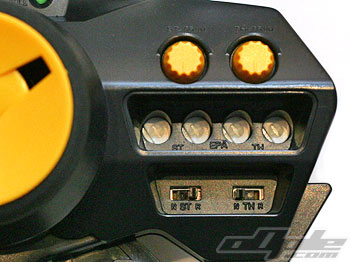 |
After 5 minutes of kitchen racing the ESC was warm, as was the motor and battery - but far from excessively so.
We took the car out for a play session and a few photos. The surfaces ranged from short grass to loose shale, with a bit of dirt thrown in for good measure.
The supplied tyres struggled on the loose surfaces with their small pins - they never really got a grip on things. On other surfaces like short grass and dirt, the tyres hooked up well enough for the spec of the car - not enough traction to make things boring. It would be nice to see meatier tyres on here though. |
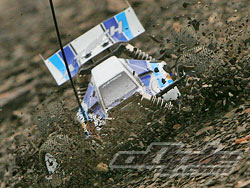 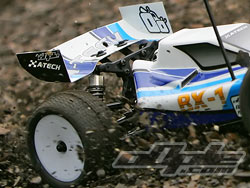 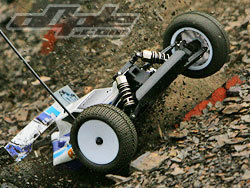
Speed from the supplied motor wasn't bad but was nothing that would tax an experienced driver. The speed is certainly suited more toward smaller areas and off-road action - "speed runs" in your local tesco carpark will leave you wanting more for sure.
The car is as fast in reverse as forward which is great fun! |
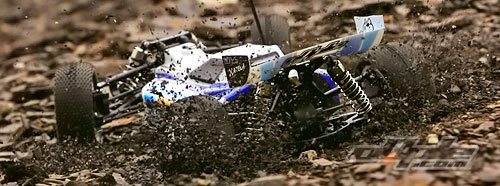 |
|


